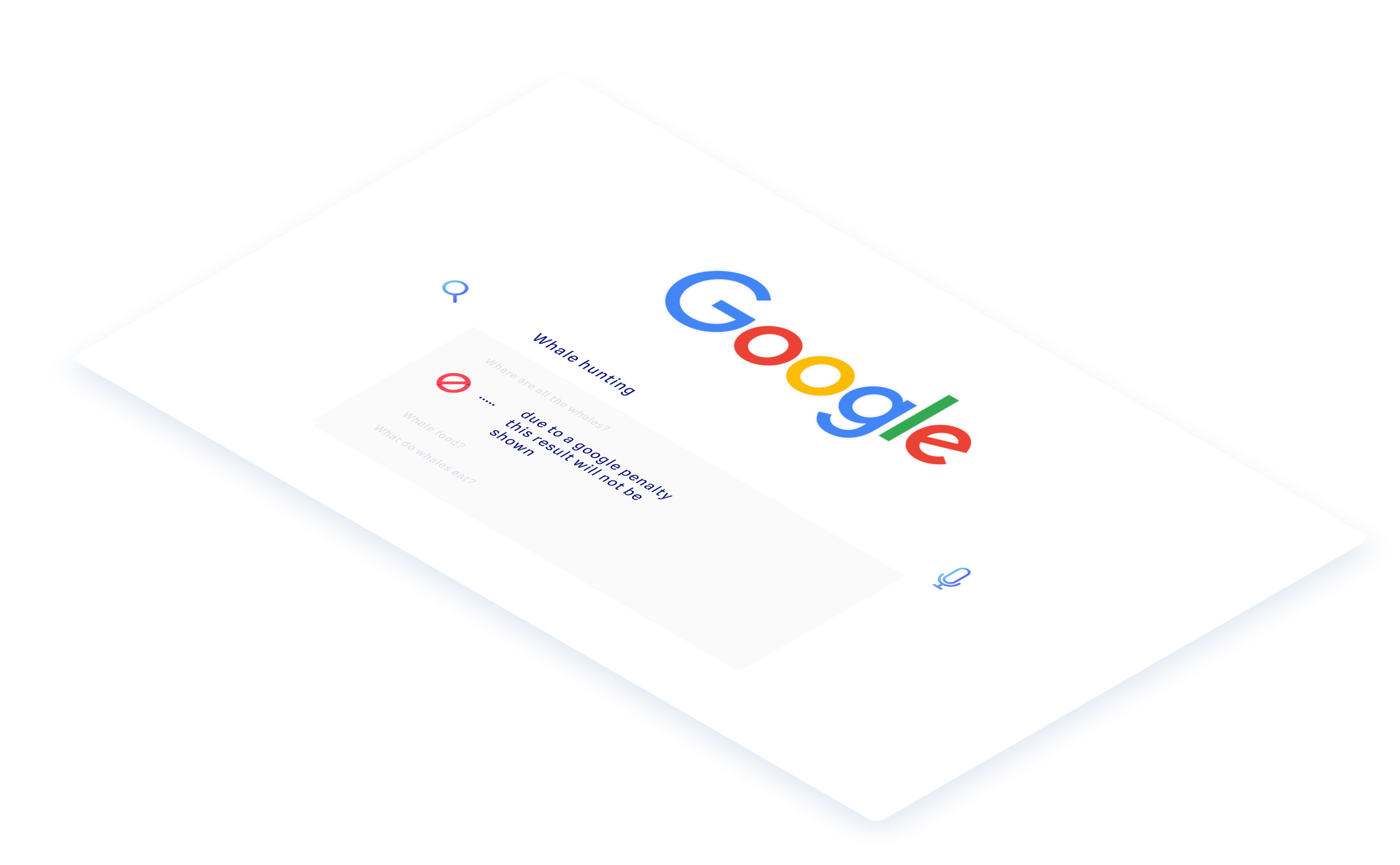
Google Penalty:
A Comprehensive Guide to Detection and Prevention
A Google penalty can have a detrimental impact on your website, potentially making it invisible to online users. Find out what these penalties entail and explore effective strategies for safeguarding your site.

The impact of a Google penalty on SEO
What exactly is a search engine penalty?
In the realm of search engine optimisation, a penalty refers to the punitive measures taken by search engines when a website fails to adhere to their guidelines (such as Google’s webmaster guidelines). These SEO penalties aim to enhance the overall quality of websites and provide users with results that align with their expectations by identifying dishonest practices and attempts to manipulate algorithms. Facing a penalty can be disastrous, particularly for e-commerce sites that heavily rely on search visibility. Since Google is the world’s most widely used search engine, our focus will be on the renowned Google penalty: understanding its nature, mastering detection techniques, and implementing effective protective measures.
What’s a Google penalty?
Google applies two types of penalties: manual and algorithmic. A manual penalty occurs when Google employees, known as “Quality Raters,” decide to penalise a website, usually due to suspected violations or user reports (such as spamming). Manual penalties are rare and typically result from deliberate misconduct. Conversely, an algorithmic penalty is automatically imposed by the search engine through filters integrated into the algorithm during significant updates. Any website can inadvertently face algorithmic penalties due to carelessness, negligence, or lack of knowledge. These penalties are particularly challenging, especially because they are difficult to detect.
Google algorithmic penalty
Let’s explore the most significant algorithmic penalties imposed by Google in recent years following major updates.

-
The Panda penalty
Introduced in 2011, Google’s Panda algorithm targets content relevance. This filter aims to prioritise high-quality content that is well-written, original, substantial, and valuable to users. Websites most affected by this penalty are those hosting duplicate content, engaging in cloaking or keyword stuffing, and providing low-quality content that offers no value.
-
The Penguin penalty
Implemented in 2012, the Penguin penalty has had a significant impact on websites. Its main objective is to identify and penalise low-quality links, especially manipulative backlinks. Given the importance of inbound links in organic search rankings, it’s not surprising that Google penalises sites that abuse these practices, such as artificial links, purchased backlinks, and suspicious redirects.
-
Security update
In 2014, Google began prioritising web security. As part of this effort, the search engine encouraged webmasters to adopt the HTTPS protocol instead of the traditional HTTP. The security update of 2014 (along with subsequent enhancements) doesn’t directly result in a penalty but alerts users when a site is not secure, potentially leading them to abandon their visit.
-
Mobile penalty
In April 2015, Google introduced a significant update known as “Mobilegeddon” due to its substantial impact on search rankings. This update aimed to prioritise mobile-friendly websites in the SERP and potentially penalise sites that were not optimised for mobile devices. Some SEO experts believe that this algorithmic change had an even more noticeable effect than the Panda and Penguin penalties.
-
Advertising penalty
In 2017, Google introduced a set of penalties to address websites that display advertisements negatively impacting the user experience on mobile devices. This includes intrusive pop-ups and aggressive interstitials that disrupt the smooth browsing experience for mobile users. Consequently, such penalties can significantly affect a site’s ranking position. It also marked one of Google’s notable steps towards prioritising user experience (UX) considerations.
What are the implications for your SEO in the event of a Google penalty?
A Google penalty can have serious repercussions on your website’s organic search ranking. So what are the implications?
-
Ranking demotion
A noticeable drop in a site’s position for specific search queries. A penalty can be identified by a sudden and significant decline in rankings.
-
Deindexing
Deindexed pages no longer appear in search results. This occurs when pages contain duplicated content or when their indexation is prevented.
-
Blacklisting
This penalty entails complete removal from the SERP. When a site is blacklisted, it is entirely excluded from Google’s search index and will not appear in search results.
What are the abusive practices that can lead to a Google penalty?
Google penalties are imposed on webmasters and SEO practitioners who fail to adhere to the search engine’s guidelines, whether unintentionally (due to a lack of knowledge or oversight) or deliberately, in an attempt to achieve rapid rankings (using Black Hat SEO techniques). Here is a range of detrimental practices that can result in a Google penalty: artificial creation of backlinks (purchasing links, acquiring a large number of inbound links within a short period, excessive optimisation of anchor texts), cloaking (presenting different content to users compared to search engine bots), keyword stuffing (excessive use of keywords in content), spamming, duplicated or low-quality content, deceptive redirects, excessive use of advertising placements, and more.
How to detect and fix a Google penalty
What to do if your site receives a Google penalty
A penalty is not the end of the road! In most cases, Google penalises unintentional practices or negligence, especially through automatic algorithmic penalties. By taking the time to identify the cause of the penalty and implementing corrective measures, you can demonstrate your good intentions and commitment to following proper SEO practices. Now let’s explore how to identify penalties imposed by the search engine and what steps should be taken to recover from them – and even better, prevent them in the first place.

How to detect Google penalty
It depends on whether the penalty is manual or algorithmic. Here’s what you need to know.
-
Detecting a manual penalty
Google notifies the administrator of the affected site about manual penalties. Through the Search Console interface (under “Security & Manual Actions”), the Quality Raters inform you about the penalty. This notification includes explanations of the reasons behind the penalty and recommendations for implementing best practices to resolve it.
-
Detecting an algorithmic penalty
Detecting algorithmic penalties from Google is more challenging as they are not explicitly communicated. If you notice unusual and unexplained changes – such as a sudden drop in traffic or a significant decline in your rankings on the SERP – and the Search Console does not indicate a manual penalty, then it’s likely that a Panda or Penguin filter has been applied. If you have recently taken a few liberties with the algorithms… that’s probably it!
How to recover from a Google penalty
The key is to undertake a series of corrective actions. For a manual penalty, simply follow Google’s recommendations. In the case of an algorithmic penalty, it’s up to you to identify the root cause of the issue. However, in both scenarios, you’ll need to take similar actions to address the problem.

-
Improve your content
Google places a high value on quality content. So, it makes sense to focus on enhancing your content to overcome Google penalties and, even better, proactively prevent them! Ensure your content is well-written, comprehensive, and primarily designed to meet the needs of your website visitors. Avoid stuffing your pages with excessive advertisements.
-
Remove duplicate content
Google specifically targets duplicated content. By “duplicate,” we mean content that appears identically on two different URLs or repetitive paragraphs within the same page. Identify and eliminate any “filler” content that is generated automatically or copied (or even plagiarised) from existing pages. Prioritise original and customised content.
-
Fix errors
Numerous technical issues can result in penalties, such as broken or misleading redirects, inconsistent AMP content, unintentionally hidden content, inadequate security protocols (HTTP), subpar mobile optimisation, and more. Conduct a comprehensive technical audit of your website to address these different aspects and ensure clean code on every page. Also, pay attention to providing a high-quality user experience.
-
Analyse backlinks
Perform a thorough analysis of your backlinks to assess their quality. Create a list of websites that have linked to your pages and identify any that appeared shortly before the penalty. Be vigilant about links originating from low-quality sites and artificial linkbuilding practices. If you come across toxic backlinks intended to harm your website, take prompt action to disavow them.
-
Monitor keywords
While keywords are crucial for SEO, it’s important to use them judiciously. Carefully select relevant queries to focus on within your pages, ensuring they align with your business and cater to your target audience’s expectations. Avoid excessive keyword usage. Google recommends maintaining a keyword density of around 1%, which means using approximately one query per hundred words.
Best SEO practices to avoid a Google penalty

The most effective way to recover from a penalty is to avoid getting penalised altogether! Following a “clean” or “White Hat” SEO strategy remains the safest approach to safeguard your website against Google penalties. Always adhere to the guidelines: focus on high-quality content that caters to users, optimise the user experience, and prioritise natural linkbuilding from reputable sites. Whether you’re striving for compliant SEO or rectifying errors that led to a penalty, collaborating with a specialised digital marketing agency is the ideal choice.

Our Commitment
-
Expertise
Since 2010, we have worked with over 2000 clients across 90 countries.
-
Passion
We are a team of passionate, industry-focused individuals who are committed to your success.
-
Performance
We’re committed to implementing a data-driven strategy, making a real impact on your bottom line by providing avenues for growth.
Any questions?
A Google penalty is a punitive measure imposed when your site fails to comply with the search engine’s established best practices. There are two primary types of Google penalty: manual penalties, which are applied by the company’s “Quality Raters,” and algorithmic penalties, which are automatically enforced through filters. Notably, Google Panda and Google Penguin are well-known algorithmic penalties.
Manual penalties are communicated through the Google Search Console, where you receive a list of recommendations to address the identified issues. Algorithmic penalties, however, are not explicitly indicated and are often discovered by chance when you observe a sudden decline in traffic volume or a significant drop in search engine rankings.
The best way to prevent a Google penalty is to practice SEO that aligns with the search engine’s guidelines. Emphasise the delivery of high-quality, original, and relevant content optimised for keywords relevant to your business. Pay attention to your linkbuilding strategy, aiming for organic backlinks from authoritative websites. Above all, avoid engaging in Black Hat SEO practices!
By engaging our digital marketing agency, you can ensure protection against a potential Google penalty.












